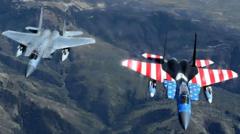More than 3,200 defense workers at Boeing initiated a strike on Monday, marking a challenging moment for the aerospace giant as it contends with internal and external issues. Union members from Missouri and Illinois, responsible for building F-15 fighter jets and other military aircraft, overwhelmingly voted against the company's recent proposal, which they deemed insufficient regarding pay, work schedules, and retirement benefits.
"We are disappointed that our employees did not accept an offer that included an average wage increase of 40%," stated Dan Gillian, vice president of Boeing's Air Dominance unit. This labor action adds to Boeing's list of troubles, which already includes safety concerns and a significant strike by passenger aircraft workers last year that lasted over seven weeks.
The strike is being organized by the St. Louis branch of the International Association of Machinists and Aerospace Workers (IAM), which represents a significant segment of the aerospace workforce. A statement from the IAM emphasized their stance: “3,200 highly-skilled IAM Union members at Boeing went on strike at midnight because enough is enough. This is about respect and dignity, not empty promises.”
The current strike marks the first disruption within Boeing’s defense sector since 1996, when a walkout lasted over three months. However, Boeing CEO Kelly Ortberg attempted to mitigate concerns about the strike's impact, noting that it would be less disruptive than last year's labor action involving about 30,000 workers, which cost the company billions.
Boeing has experienced a tumultuous period, facing multiple crises including two fatal aircraft crashes and operational difficulties with the 737 series. In 2018, a crash in Indonesia claimed the lives of 189 individuals, with another tragedy occurring months later in Ethiopia. Compounding matters, a panel on a 737 Max came loose mid-flight earlier this year, raising alarm among regulators and passengers. Last year, Boeing delivered only 348 aircraft, representing its lowest output since the onset of the pandemic.




















